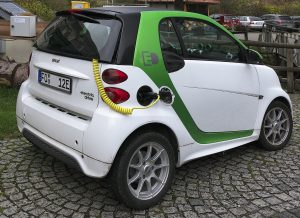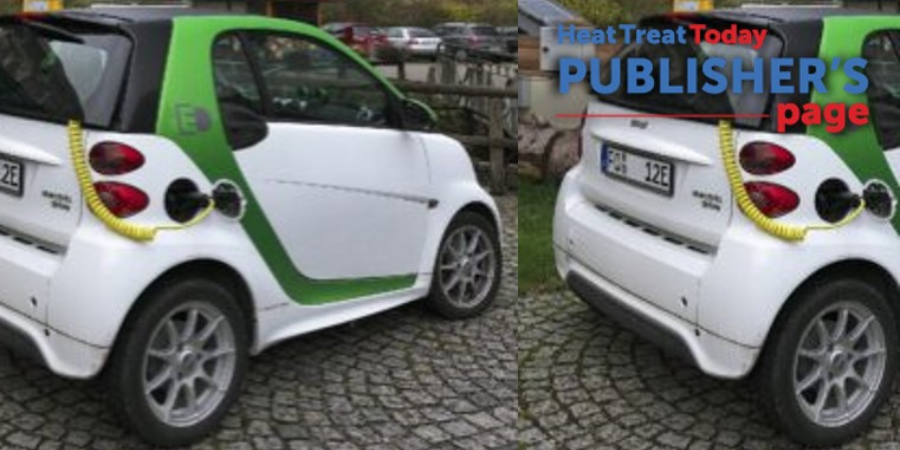![]() Heat Treat Today publishes four print magazines a year, and included in each is a letter from the publisher, Doug Glenn. This letter first appeared in Heat Treat Today‘s Automotive Heat Treating magazine, June 2019
Heat Treat Today publishes four print magazines a year, and included in each is a letter from the publisher, Doug Glenn. This letter first appeared in Heat Treat Today‘s Automotive Heat Treating magazine, June 2019

If you believe YouTube, the very first car was a Benz Motorwagen (1885). It was petro-powered. For the last 134 years, there have been only petro-powered vehicles.
Cars aren’t going away (drivers might be going away, but not cars!), but evidence seems to point to the soon extinction of the petro-powered vehicle. Every major automobile manufacturing company has a horse in the game. Volvo, the Chinese-owned Swedish car company, has committed to building ONLY all electric or hybrid cars starting in 2019. It plans to introduce five new, all electric models between 2019 and 2021.
What of the heat treat supply chain? Will automotive heat treating dry up to a paltry percentage of what it is now? Will automotive electrification usher in new heat treat opportunities?
Without a doubt, electrification will bring in a brave new world to heat treating, but I’ve not seen anyone present a good, in-depth analysis of how the heat treat world will be impacted. If you’ve seen such a presentation, I’d like to know.
What Will Go Away
What can be said is pretty straightforward. Assuming the current trajectory continues, the petro-powered engines that have propelled our vehicles for that last century and a half will slowly start to disappear. In their place will be electric motors and battery power. Specifically, gears and transmissions will take a significant hit. Currently, the heat treatment of gears is one of the largest segments of heat treating with all the carburizing, nitriding, carbonitriding, ferritic nitrocarburizing, and a seemingly endless number of other surface or through heat treat processes. Per car, there are more gears heat treated than any other single component. Pistons, fuel injectors, cylinders, rings, and anything else related to the internal combustion engine will wane as the popularity of EVs waxes.
As one of our heat treat consultants says in this issue’s article, “Heat Treat Brain Trust on Industry Innovations That Have Enhanced Automotive Heat Treating in Recent Years,” we have to also consider the upstream supply chain that will be affected by the displacement of the internal combustion engine. What about tooling and toolmakers and the heat treating they currently do? What about the heat treating that is required after soft machining and then again after hard machining? Keep looking further and further back the supply chain to discover who else will be impacted by electrification.
It will be a paradigm shift, a mega-trend, a tsunami of epic proportion . . . maybe even a train wreck in slow motion.
But that is the saving grace. None of this is going to happen overnight. So if your horse is hitched to the internal combustion engine, the 2020s is a good time to start looking for another ride home from the dance.
“Without a doubt, electrification will bring in a brave new world to heat treating, but I’ve not seen anyone present a good, in-depth analysis of how the heat treat world will be impacted.”
What Won’t Go Away
On the other hand, there’s plenty that will not be going away. Body panels and structural components/frames, suspension parts (although they may change due to the vehicles having a motor on each of their four wheels), and non-engine related stampings and forgings will all make the cut. But even these parts are not completely safe. The push for lighter, stronger vehicles will continue to push designers to consider lighter materials with equivalent or superior functionality. Take wheels for example. Carbon fiber is superior but too expensive for the average pocketbook, but high-end vehicles are already sporting these high-tech wheels. The days of aluminum wheels may be limited. Auto manufacturers will continue to push for less expensive, higher performing materials which, in some cases, will include non-metallic, non-heat treatable composite materials.

What’s Coming
On May 8 of this year, our publication ran the following article: “First Aluminum Sheet Battery Enclosure Helps Electric Vehicles Go Farther on a Single Charge.” In that article, Novelis Inc.’s Pierre Labat, VP of Global Automotive, announced the first aluminum sheet battery enclosure for “the rapidly growing electric vehicle and battery sectors.” Batteries. Hitch your wagon to anything battery related!
Additionally, electric motor production and anything upstream in that supply chain would be a safe bet to investigate.
No one has ever accused me of lacking imagination, but I’m having a difficult time seeing a net gain for heat treaters in the coming EV swell. Then again, the free market and human innovation – which is especially strong in these United States – is a wonderful thing. We will adapt. Fortunately, we have some time – probably two decades of slow change. Embrace the change. Prepare for the future.







